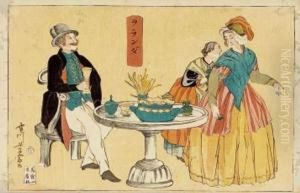Utagawa Yoshimune Paintings
Utagawa Yoshimune was a Japanese ukiyo-e artist who was active during the late Edo period and the beginning of the Meiji era. He was born in 1817 in Edo (present-day Tokyo), Japan. Yoshimune was a member of the Utagawa school, which was one of the most prominent and influential schools of Japanese woodblock printing, known for producing works in the ukiyo-e genre. The school was founded by Utagawa Toyoharu and later came to prominence under the leadership of Utagawa Toyokuni I.
Yoshimune was known to be a student of Utagawa Kuniyoshi, one of the last great masters of the ukiyo-e style of woodblock prints and paintings. Kuniyoshi was renowned for his depictions of historical and folk tales, landscapes, and particularly for his portrayals of warriors and animals. Under Kuniyoshi's guidance, Yoshimune honed his skills in drawing and printmaking, becoming proficient in creating images that were vibrant and detailed.
During his career, Utagawa Yoshimune produced a variety of works including prints of actors (yakusha-e), beautiful women (bijin-ga), and occasionally landscapes and warrior prints. However, compared to his contemporaries and the more famous artists of the Utagawa school, Yoshimune's work did not gain the same level of fame and recognition. His prints did contribute to the rich tapestry of ukiyo-e culture during a time when Japan was undergoing significant political, social, and cultural changes due to the opening of its borders to the West and the subsequent modernization efforts of the Meiji Restoration.
Yoshimune's works are characterized by their clear lines, use of color, and attention to detail, which were hallmarks of the Utagawa school's style. Although not as widely studied as other ukiyo-e artists, his contributions to the genre are still recognized by those who appreciate the art of Japanese woodblock printing.
Utagawa Yoshimune passed away in 1880. His works, like those of many other ukiyo-e artists, provide valuable insights into the cultural and artistic traditions of Japan during a time of significant transition. Despite his relatively modest reputation, his prints remain a part of the historical record of the ukiyo-e movement and continue to be appreciated by collectors and enthusiasts of Japanese art.
![] Chushingura Emaki](https://www.niceartgallery.com/imgs/1124891/s/utagawa-yoshimune-chushingura-emaki-85879340.jpg)
